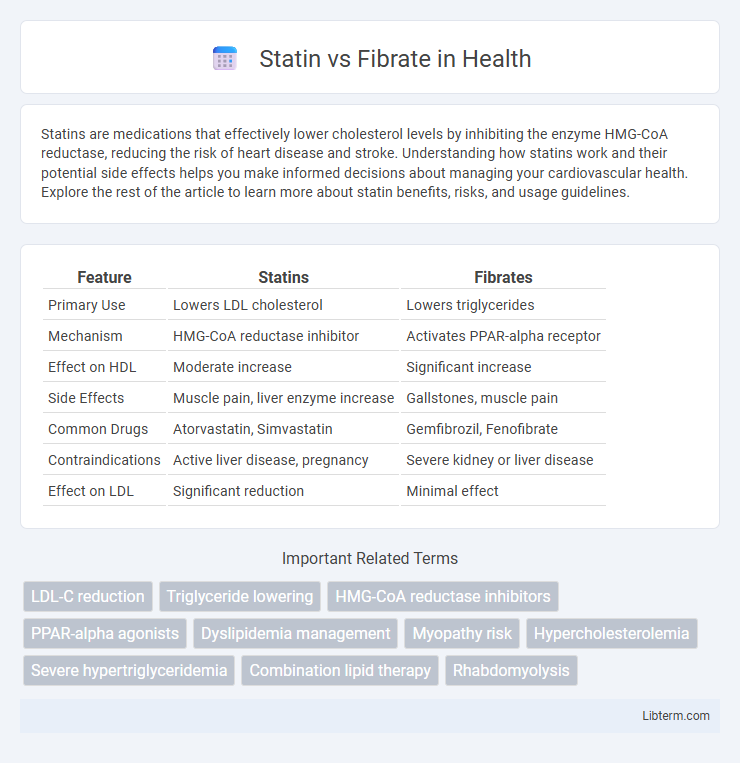Statins are medications that effectively lower cholesterol levels by inhibiting the enzyme HMG-CoA reductase, reducing the risk of heart disease and stroke. Understanding how statins work and their potential side effects helps you make informed decisions about managing your cardiovascular health. Explore the rest of the article to learn more about statin benefits, risks, and usage guidelines.
Table of Comparison
| Feature | Statins | Fibrates |
|---|---|---|
| Primary Use | Lowers LDL cholesterol | Lowers triglycerides |
| Mechanism | HMG-CoA reductase inhibitor | Activates PPAR-alpha receptor |
| Effect on HDL | Moderate increase | Significant increase |
| Side Effects | Muscle pain, liver enzyme increase | Gallstones, muscle pain |
| Common Drugs | Atorvastatin, Simvastatin | Gemfibrozil, Fenofibrate |
| Contraindications | Active liver disease, pregnancy | Severe kidney or liver disease |
| Effect on LDL | Significant reduction | Minimal effect |
Introduction to Statins and Fibrates
Statins and fibrates are two primary classes of lipid-lowering agents used to manage dyslipidemia and reduce cardiovascular risk. Statins inhibit HMG-CoA reductase, effectively lowering LDL cholesterol levels and stabilizing atherosclerotic plaques for improved cardiovascular outcomes. Fibrates activate peroxisome proliferator-activated receptors (PPARs), primarily reducing triglycerides and increasing HDL cholesterol, making them especially beneficial in treating hypertriglyceridemia and mixed dyslipidemia.
Mechanisms of Action: Statins vs Fibrates
Statins primarily inhibit HMG-CoA reductase, the key enzyme in cholesterol biosynthesis, leading to a significant reduction in LDL cholesterol levels. Fibrates activate peroxisome proliferator-activated receptors (PPARa), enhancing lipoprotein lipase activity, which increases the catabolism of triglyceride-rich lipoproteins and raises HDL cholesterol. The distinct mechanisms of action make statins more effective for lowering LDL cholesterol, while fibrates target triglycerides and HDL modulation.
Indications and Approved Uses
Statins are primarily indicated for lowering LDL cholesterol and reducing cardiovascular risk in patients with hypercholesterolemia or atherosclerotic cardiovascular disease. Fibrates are approved mainly for managing hypertriglyceridemia and mixed dyslipidemia by decreasing triglycerides and increasing HDL cholesterol levels. Both drug classes have distinct roles in lipid management based on specific lipid abnormalities and patient risk profiles.
Comparative Efficacy in Lowering Cholesterol
Statins primarily inhibit HMG-CoA reductase to effectively reduce low-density lipoprotein cholesterol (LDL-C) levels, achieving reductions of up to 50% or more. Fibrates act by activating peroxisome proliferator-activated receptors (PPARs), mainly lowering triglycerides and moderately increasing high-density lipoprotein cholesterol (HDL-C), but have a less pronounced effect on LDL-C. Comparative studies consistently show statins outperform fibrates in lowering LDL-C, making statins the first-line therapy for hypercholesterolemia management.
Impact on Triglycerides and HDL Cholesterol
Statins primarily reduce LDL cholesterol but have a moderate effect on lowering triglycerides and raising HDL cholesterol. Fibrates are more effective in significantly lowering triglycerides and modestly increasing HDL cholesterol, making them particularly useful in managing hypertriglyceridemia. Combining statins and fibrates can enhance lipid profile improvement but requires careful monitoring due to increased risk of side effects.
Side Effects and Safety Profiles
Statins primarily cause muscle pain, elevated liver enzymes, and a small risk of diabetes, while fibrates commonly lead to gastrointestinal disturbances, gallstones, and elevated liver enzymes. Statins have a well-established safety profile supported by extensive cardiovascular outcome trials, whereas fibrates show variable safety depending on the specific agent and patient profile. Combining statins with fibrates increases the risk of muscle toxicity, requiring careful monitoring to mitigate adverse effects.
Drug Interactions and Contraindications
Statins exhibit significant drug interactions with CYP3A4 inhibitors like ketoconazole and clarithromycin, which can elevate statin plasma levels and increase the risk of myopathy and rhabdomyolysis. Fibrates, particularly gemfibrozil, interact with statins by inhibiting glucuronidation, thereby raising statin concentrations and enhancing muscle toxicity risk. Contraindications for statins include active liver disease and pregnancy, while fibrates are contraindicated in severe renal impairment and gallbladder disease due to their distinct metabolic and excretory pathways.
Clinical Guidelines and Recommendations
Clinical guidelines prioritize statins as first-line therapy for managing dyslipidemia due to their proven efficacy in reducing LDL cholesterol and cardiovascular risk. Fibrates are recommended primarily for patients with severe hypertriglyceridemia or mixed dyslipidemia who do not achieve target lipid levels with statins alone. Guidelines from organizations like the American College of Cardiology and the European Society of Cardiology emphasize combination therapy cautiously, monitoring for potential adverse effects.
Statins vs Fibrates: Patient Selection Criteria
Statins are primarily prescribed for patients with elevated LDL cholesterol and cardiovascular risk factors, while fibrates target individuals with high triglyceride levels and low HDL cholesterol. Patient selection depends on lipid profile, coexisting conditions like diabetes or metabolic syndrome, and potential drug interactions. Statins are preferred for atherosclerotic cardiovascular disease prevention, whereas fibrates are chosen for hypertriglyceridemia to reduce pancreatitis risk.
Future Directions and Ongoing Research
Emerging research on statins and fibrates explores their synergistic potential for enhanced lipid control and cardiovascular risk reduction. Advanced studies are investigating gene therapy and personalized medicine to optimize statin and fibrate efficacy based on individual genetic profiles. Clinical trials are also assessing novel combination therapies targeting both LDL cholesterol and triglycerides to improve outcomes in patients with mixed dyslipidemia.
Statin Infographic

 libterm.com
libterm.com